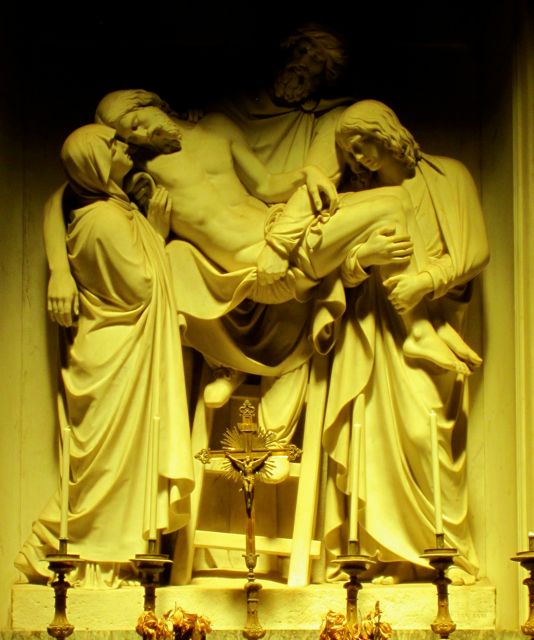
Of all christian subjects in art, it is the removal of Jesus from the Cross which seems to stir me the most. It is odd that this be the case, since I am rather more Easter than I am Lent. It is not that I have trouble being empathetic about suffering. I cry in Disney films, let alone seeing real human suffering. I have simply spent too many hours with Buddhist monks discussing the difference between suffering and pain.
Pain is a mother at the Cross with her little boy (now in his 30’s but still, always, her little boy). Pain is a best friend standing with his friend’s mother, watching two people he loves experience pain and loss. Pain is Jesus with his body cut and pierced. Pain is Jesus’ silence about where the other disciples are at a time like this. Pain is the betrayal of his closest followers and what seemed like the abandonment of his God. Pain abounds in the story we tell of our Savior. And that the pain is modeled for us in quite this way is, at least for me, a valuable lending of courage when I experience those things in my own life.
The difference between pain and suffering is hidden not only in Buddhist thought but in Christian art. Mary and John have no “shoulds” here. Mary is not lecturing the guards that this is not the way a person should be treated. John is not compelling the guards to stop this form of punishment. Even Jesus is not telling God that things should be different. He simply asks God a question from that moment’s mind. Nowhere in scripture do we have an account of a lobby for Jesus to be removed from the cross. Not even from Jesus.
“People should not betray me!” is suffering. “I have been betrayed.” is pain.
“Our friend should not be killed!” is suffering. “Our friend has been killed!” is pain.
“People should not ever lie to me.!” is suffering “People have lied to me!” is pain.
“It should not rain on my outdoor wedding!” is suffering. “I am filled with grief that my outdoor wedding has been rained out!” is pain.
“There should be no illness in the world.” is suffering. “My beloved one is dying of cancer and I am being torn apart by it.” is pain – even agony – but not suffering.
In the end, it comes down to our thoughts. Do we believe them simply because they pop into our minds? Do we fluff the pillows for every thought which enters the living room of our mind, taking it by the hand and uniting it with rage? Or are we discerning – able to separate the difference between what is happening, and how we are responding to what is happening? To do this separating is a mature and centered way to live. This work will be central to the Art of Hosting work we all do together on October 11 in just 13 or so weeks.
“People should not betray me!” … is that true? Because indeed, people betray other people to get what they want all the time. It happens every day. It has happened throughout history. It has happened in the church. And it will continue to happen whenever egos enflame. The question is not “Should this happen?” It will. It does.
The question is “Will I respond by nursing the thoughts which enter my brain, fanning their flames with the winds of my outrage, or will I see that, by refusing to suffer – by choosing only to feel pain, I am claiming my ability to respond in such a way as not to make a bad thing worse – for me and for the planet. It is hard work. It takes profound humility, self-awareness and courage. And it is the most liberating act a human can accomplish.
So when one see images like this reredos of Jesus being removed by Mary and John, it reminds one that in order to hold the corpse of a beloved friend, one needs first to put down the posters on sticks, the pitchforks and the torches – all signs of outrage.
The question is not “What will happen to me?”
The question is “How will I respond to what is happening?”

